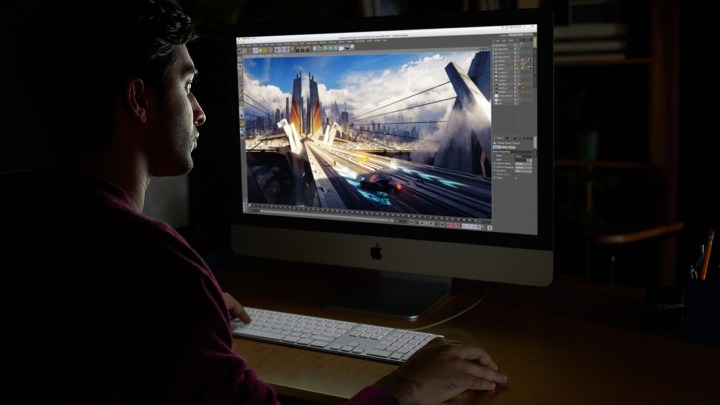

It was an apology to Mac fans.
“Don’t worry,” the company seemed to say. “Apple is still working on high-end, incredibly fast Macs, and that hardware is coming soon.” At WWDC 2017, we saw at least a portion of what the company has in store. New hardware debuted with a look at real-time movie scene composition in the Star Wars universe, complete with a cameo by Darth Vader himself.
It was an impressive demo that distracted from a less attractive truth. The Mac is still in a tough spot, and Apple’s commitment to it remains uncertain.
And on to the next thing
Apple devoted a half hour of its two-and-a-half-hour keynote to MacOS and Mac hardware. That sounds like more time than it is, and even Apple’s veteran Craig Federighi stumbled occasionally as he sped through features and demos at light speed. The breakneck presentation contrasted starkly against the full hour devoted to iOS and iPad Pro, which gave presenters more time to relax. Even the Apple Watch received about 20 minutes of stage time, which was devoted to important advancements, such as new Toy Story-themed watch faces.
Apple is iOS, and iOS is Apple – everything else remains optional. The Mac is perhaps most optional of all.
It may seem petty, but how Apple uses the time in its keynote says a lot about its priorities. Apple is iOS, and iOS is Apple – everything else remains optional. The Mac is perhaps most optional of all.
Still, the short run-time may’ve been for the best, because Apple’s Mac announcements were, yet again, light on content. MacOS High Sierra’s only consequential update is the switch to a new file system, which should improve performance, and could enable new features going forward.
Everything else is the kind of minor improvement Microsoft buries in Windows Insider patch notes on a regular basis. Safari’s faster, while Mail and Photos receive interface tweaks. The announcement of HVEC support encoding acceleration was almost embarrassing. At this point it’s widespread, as Intel added hardware acceleration of 4K HVEC in its 7th-generation Core. Last year.
The pace of MacOS is glacial. Microsoft may have a problem with over-promising the scope of its updates, but it at least delivers major Windows 10 features on a regular basis. MacOS looks positively frozen by comparison, and the updates announced at WWDC do nothing to change that.
The hardware isn’t as exciting as it looks
But wait! What about Mac hardware? Apple breezed through a slew of updates to the iMac and MacBook Pro, and teased the upcoming iMac Pro, its most powerful device ever. Certainly, that’s worth excitement?

Well…no. Not really.
Let’s deal with the updates first. Apple showed off numerous enhancements to the MacBook Pro and iMac line, with a focus on CPU and GPU hardware. Intel’s 7th-gen Core processors are now standard across the board, and some models now have better discrete graphics.
That’s good, obviously. An upgrade is an upgrade. Yet this hardware isn’t new. Launching the new MacBook Pros without Intel’s latest hardware was a miss, and Apple doesn’t deserve accolades for finally making the switch over half a year later. The iMac is also late to make the switch.
Apple’s vision of tomorrow’s PC is in an awkward place.
Which brings us to the iMac Pro, most exciting of all the announcements. This is Apple’s attempt to convince professionals that Apple still cares about performance, and it looks convincing at a glance. The iMac Pro will combine a gorgeous 5K display with AMD’s new Vega GPU and Intel’s latest 18-core processor. It’ll even support up to 128GB of memory.
It’d be bleeding-edge stuff if it launched today. It’s not. Instead it’s shipping in December. By then, all the major Windows PC builders will have their own 18-core, Vega-capable desktops available. They too will be available with 5K displays – or 8K, if you buy Dell’s latest. And unlike the iMac Pro, they’ll be easily serviceable and upgradable, so owners can update as new hardware comes out.
Where’s Apple going with Mac?
The keynote was more than just a disappoint for MacOS fans. It was also a reminder that Apple’s vision of tomorrow’s PC is in an awkward place. It’s split across two operating systems, MacOS and iOS. While the former is far more capable today, Apple seems to think the latter is the real future – even for professional users.
That led to awkward moments. Take the iPad Pro’s new display, for example. The new models can refresh at up to 120Hz, yet can also refresh at slower speeds, depending on the content shown. This adaptive refresh rate technology is akin to PC technologies like G-Sync and FreeSync. Such technology remains nowhere to be seen on the Mac. In fact, none of Apple’s iMacs or MacBooks ship with a display that can refresh more than 60 times per second.

A similar dilemma plagues touch support. The iPad Pro with Apple Pen has all kinds of fancy tricks. It can add notes to documents or create artwork in Adobe Photoshop, features that touchscreen PCs can also claim. The Mac, meanwhile, is left out. Stylus support isn’t part of the OS, and only possible in specific software with the purchase of an expensive third-party touch display, like Wacom’s $2,800 Cintiq 27QHD Touch.
The new iMac Pro will be fast, and it will be beautiful – but don’t be fooled. Macs stand on thin ice. They’re overshadowed by iOS in developer and designer attention, and the quality of the Mac continues to suffer. The iMac Pro is a very expensive, elegantly designed Band-Aid applied to a patient in desperate need of surgery.


